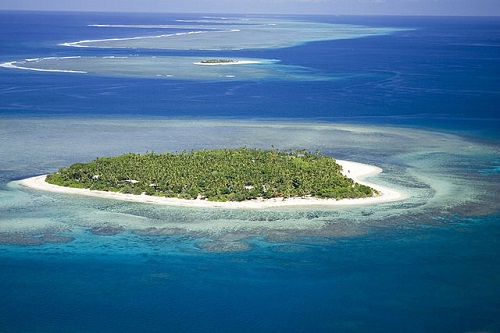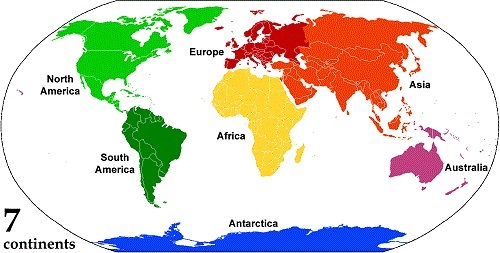Difference Between Island and Continent

Tavarua Island
Island vs. Continent
Looking at a world map or a globe, one could easily identify a continent from an island. The difference does not lie solely in their size but in many other aspects as well.
The most notable difference between a continent and an island is in their size. Continents can span a huge amount of landmass and can include numerous countries; they can also be separated by countries with respect to physical and political borders. In contrast, an island has the generic description as a small landmass surrounded by bodies of water on each side.
Drifting away from the obvious difference in size, the continents are also different from an island due to the fact that they have various landforms and fauna and flora (animals and plants). Since the landmass is so large, many people from different cultures can live together on the same continent within their own borders. An island can only accommodate a small group of people at one time.
An island can be given its own name, while continents that are close to each other can be considered and called as one. This often applies to Europe and Asia since both continents are linked together by land; the name “Eurasia” combines Europe and Asia, though each continent is not always treated this way due to the political and cultural differences.
Most of any given continent’s culture is different from that of other continents. An island might also have a culture that is entirely different from the continent it is on, or it might be ascribed to the continent’s governance and culture if said island is part of the continent or a specific country’s territory.
In other terms, a continent can be defined with respect to its location. Continents sit on a tectonic plate and occupy a large portion of that plate. Islands are often scattered toward a plate or in between plates.

Another obvious difference is in the number of continents and islands found in the world. Obviously, there are more islands than continents; there are approximately 18,995 islands in the world, while there are only 7 recognized continents. The continents’ names are easier to remember: Europe, Asia, North America, South America, Africa, Australia, and Antarctica.
A major factor to consider is the fact that continents cannot be manmade or disappear within a certain level of tide. The reason for the approximate number of islands is that the Earth is constantly changing – forming and swallowing up islands along the way.
In order to sustain and make use of space for an overwhelming population, humans can now create manmade and recreational islands. These islands are a marvel of technology and human ingenuity. They can accommodate structures and a number of people that can live in that particular space. In contrast, continents cannot be manmade due to their sheer size. If humans had the technology and resources for this, there would be no more space left on Earth. Some people consider continents as islands that are just bigger in size.
Summary:
1.Continents and islands differ in terms of size; continents are bigger and wider than islands.
2.Islands are also more numerous – approximately 18,995 – compared to only 7 continents.
3.Islands can be manmade with the proper technology and equipment, while continents would be a challenge to create using human resources.
4.A continent can contain a wide range of unique cultures as well as fauna and flora, distinct from those found on other continents, while an island can only contain features on a smaller scale and scope.
- Differences Between Fraternity And Sorority - January 8, 2014
- Differences Between Lucite and Plastic - January 7, 2014
- Differences Between Oil and Butter - January 6, 2014
Search DifferenceBetween.net :
3 Comments
Leave a Response
References :
[0]https://sv.wikipedia.org/wiki/Tavarua_Island
[1]https://nso.m.wikipedia.org/wiki/Seswant%C5%A1ho:Continental_models-Australia.gif

Great ρost.
Terrible post. Politics and man made borders do not define what seperates island from continent
I very much agree with Liam, you cannot cite sociologically defined geographical borders as “fact” when it is impossible to have an unbiased view of this topic. Even when talking about the “obvious” size differences between islands and continents that is present in maps, this view point does not even speak to how all map projections distort size, area, and direction to some degree. We talk about the 7 continents because we just have not challenged the concept yet, instead of perpetuating these outdated views, this article should question what has been taught in schools for so long.